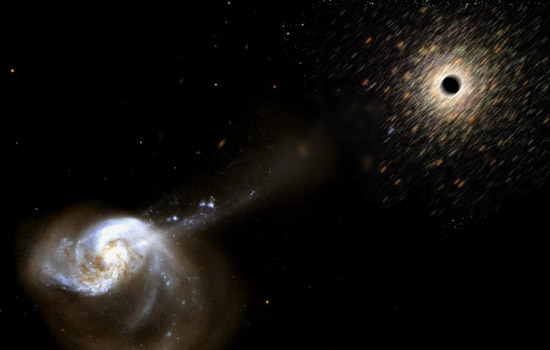Living Fossils Hold Record of ‘Supermassive’ Kick
Star clusters point to black holes ejected from host galaxies
Space Telescope Science Institute
This artist’s conception shows a rogue black hole that has been kicked out from the center of two merging galaxies. The black hole is surrounded by a cluster of stars that were ripped from the galaxies. New calculations by David Merritt, from Rochester Institute of Technology, Jeremy Schnittman, from Johns Hopkins University, and Stefanie Komossa, from the Max-Planck-Institute for Extraterrestrial Physics in Germany suggest that hundreds of massive black holes, left over from the epoch of galaxy formation, are waiting to be detected in the nearby universe.
The tight cluster of stars surrounding a supermassive black hole after it has been violently kicked out of a galaxy represents a new kind of astronomical object and a fossil record of the kick.
A paper published in the July 10 issue of The Astrophysical Journal discusses the theoretical properties of “hypercompact stellar systems” and suggests that hundreds of these faint star clusters might be detected at optical wavelengths in our immediate cosmic environment. Some of these objects may already have been picked up in astronomical surveys, reports David Merritt, from Rochester Institute of Technology, Jeremy Schnittman, from Johns Hopkins University, and Stefanie Komossa, from the Max-Planck-Institut for Extraterrestrial Physics in Germany.
Hypercompact stellar systems result when a supermassive black hole is violently ejected from a galaxy, following a merger with another supermassive black hole. The evicted black hole rips stars from the galaxy as it is thrown out. The stars closest to the black hole move in tandem with the massive object and become a permanent record of the velocity at which the kick occurred.
“You can measure how big the kick was by measuring how fast the stars are moving around the black hole,” says Merritt, professor of physics at RIT. “Only stars orbiting faster than the kick velocity remain attached to the black hole after the kick. These stars carry with them a kind of fossil record of the kick, even after the black hole has slowed down. In principle, you can reconstruct the properties of the kick, which is nice because there would be no other way to do it.”
“Finding these objects would be like discovering DNA from a long-extinct species,” adds Komossa.
The best place to find hypercompact stellar systems, the authors argued, is in cluster of galaxies like the nearby Coma and Virgo clusters. These dense regions of space contain thousands of galaxies that have been merging for a long time. Merging galaxies result in merging black holes, which is a prerequisite for the kicks.
“Even if the black hole gets kicked out of one galaxy, it’s still going to be gravitationally bound to the whole cluster of galaxies,” Merritt says. “The total gravity of all the galaxies is acting on that black hole. If it was ever produced, it’s still going to be there somewhere in that cluster.”
Merritt and his co-authors think that scientists may have already seen hypercompact stellar systems and not realized it. These objects would be easy to mistake for common star systems like globular clusters. The key signature making hypercompact stellar systems unique is a high internal velocity. This is detectable only by measuring the velocities of stars moving around the black hole, a difficult measurement that would require a long time exposure on a large telescope.
From time to time, a hypercompact stellar system will make its presence known in a much more dramatic way, when one of the stars is tidally disrupted by the supermassive black hole. In this case, gravity stretches the star and sucks it into the black hole. The star is torn apart, causing a beacon-like flare that signals a black hole. The possibility of detecting one of these “recoil flares” was first discussed in an August 2008 paper by co-authors Merritt and Komossa.
“The only contact of these floating black holes with the rest of the universe is through their armada of stars,” Merritt says, “with an occasional display of stellar fireworks to signal ‘here we are.’”
Suggested caption: This artist’s conception shows a rogue black hole that has been kicked out from the center of two merging galaxies. The black hole is surrounded by a cluster of stars that were ripped from the galaxies. New calculations by David Merritt, from Rochester Institute of Technology, Jeremy Schnittman, from Johns Hopkins University, and Stefanie Komossa, from the Max-Planck-Institut for Extraterrestrial Physics in Germany suggest that hundreds of massive black holes, left over from the epoch of galaxy formation, are waiting to be detected in the nearby universe.
Credit: Space Telescope Science Institute
Contact: David Merritt
Department of Physics - Rochester Institute of Technology
Phone: 585-475-7973













